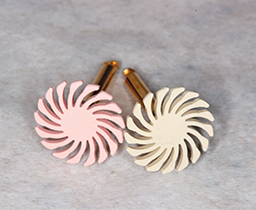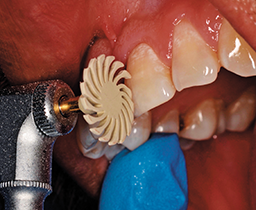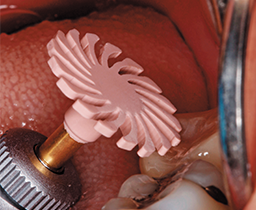How to polish composite restorations with Footsie
The new polishers from Komet USA reduce polishing procedures down to two quick and easy steps.

Completion of a cavityrestoration includes finishing and polishing to ensure smoothness. This smoothness minimizes bacterial adherence to the restored surface, encourages the maintenance of proper oral health, and creates an esthetically pleasing appearance by mimicking the adjacent teeth
Common polishing methods for composites include the use of multi-fluted carbide burs, white stones, or sandpaper discs. Although these methods may achieve their purpose, Komet® Footsie™composite polishers stand in a class above the rest (Fig. 1). Constructed from polyurethane with interspersed diamond grit, they have exquisite flexibility and unparalleled polishing ability.
Komet Footsie composite polishers (94028M, pink pre-polish and 94028F, light yellow finishing).

Footsie’s innovative design - like legs with flexed feet - provides exceptional access to otherwise inaccessible grooves and embrasures. Additionally, they don’t need to be used in any one direction to produce optimal results. The polishers achieve a brilliant finished surface quality on both anterior and posterior composites; occlusal, buccal, lingual and even interproximal. These polishers, amazingly, don’t harm adjacent tooth or gingiva structures. Furthermore, this design has also proven to be more durable; the polishers resist breakage during the suggested two-step sequence.
For anterior use, Footsie polishers are remarkable. After shaping an anterior composite, the last thing a clinician wants is an accidental nick in the restoration. Footsie polishers don’t reduce composite or tooth structure; rather, they polish and finish the restoration, rendering a lifelike appearance as well as desired restoration-surface quality.
Clinical application
Designed for use in a slow-speed latch handpiece, Footsie polishers are used in a simple two-step process:
After filling the restoration and making gross adjustments, pre-moisten the tooth - water is not required during polishing - and use the pink polisher (94028M) for pre-polishing of the surface (Fig. 2). Use a light touch, allowing the polishers to do the work.
Follow up with light yellow polisher (94028F) for a high-shine finish (Fig. 3). As demonstrated, the polishers are appropriate for use on posterior and anterior teeth.


Fig. 2 Fig. 3
With a recommended speed of up to 6,000 RPM, the polishers don’t heat up the tooth. Additionally, because water isn’t needed during polishing, the shine of the restoration can be accurately judged while using the instrument. With a highly durable construction that enables them to be sterilized and used multiple times, Footsie polishers offer an exceptional single-shape alternative to switching between cups, points and discs during multi-step polishing procedures.

Product Bites – November 10, 2023
November 10th 2023The weekly new products podcast from Dental Products Report is back. With a quick look at all of the newest dental product launches, Product Bites makes sure you don't miss the next innovation for your practice. This week's Product Bites podcast features new launches from Amann Girrbach, DMG, Pac-Dent, and ASI Dental Specialties. [4 Minutes]
ACTIVA BioACTIVE Bulk Flow Marks Pulpdent’s First Major Product Release in 4 Years
December 12th 2024Next-generation bulk-fill dental restorative raises the standard of care for bulk-fill procedures by providing natural remineralization support, while also overcoming current bulk-fill limitations.
Product Bites – October 27, 2023
October 27th 2023Product Bites makes sure you don't miss the next innovation for your practice. This week's Product Bites podcast features new launches from Kerr Dental, MGF, PreXion, ZimVie, Amann Girrbach, VOCO, ASI Dental Specialties, DMG, and NovoDynamics. [8 Minutes]